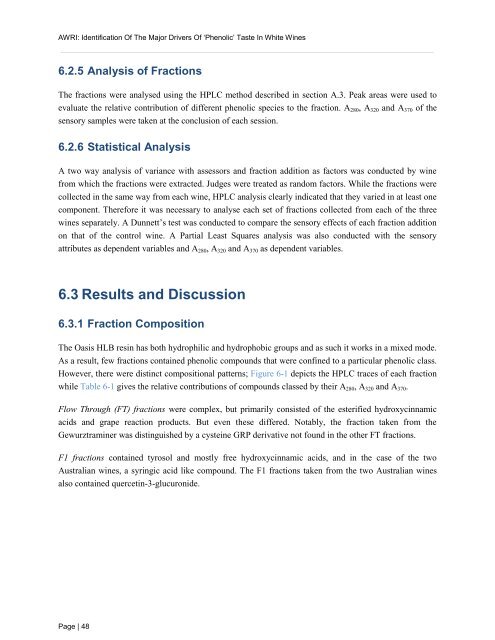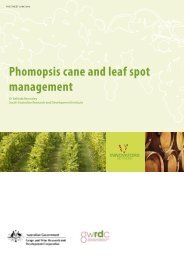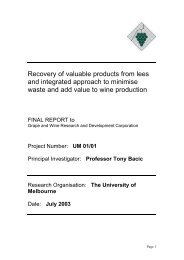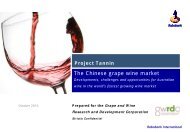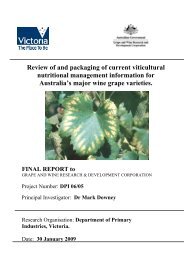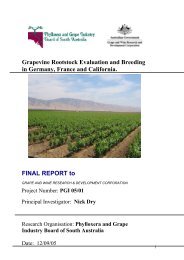Identification of the major drivers of 'phenolic' taste in ... - GWRDC
Identification of the major drivers of 'phenolic' taste in ... - GWRDC
Identification of the major drivers of 'phenolic' taste in ... - GWRDC
Create successful ePaper yourself
Turn your PDF publications into a flip-book with our unique Google optimized e-Paper software.
AWRI: <strong>Identification</strong> Of The Major Drivers Of ‘Phenolic’ Taste In White W<strong>in</strong>es<br />
6.2.5 Analysis <strong>of</strong> Fractions<br />
The fractions were analysed us<strong>in</strong>g <strong>the</strong> HPLC method described <strong>in</strong> section A.3. Peak areas were used to<br />
evaluate <strong>the</strong> relative contribution <strong>of</strong> different phenolic species to <strong>the</strong> fraction. A280, A320 and A370 <strong>of</strong> <strong>the</strong><br />
sensory samples were taken at <strong>the</strong> conclusion <strong>of</strong> each session.<br />
6.2.6 Statistical Analysis<br />
A two way analysis <strong>of</strong> variance with assessors and fraction addition as factors was conducted by w<strong>in</strong>e<br />
from which <strong>the</strong> fractions were extracted. Judges were treated as random factors. While <strong>the</strong> fractions were<br />
collected <strong>in</strong> <strong>the</strong> same way from each w<strong>in</strong>e, HPLC analysis clearly <strong>in</strong>dicated that <strong>the</strong>y varied <strong>in</strong> at least one<br />
component. Therefore it was necessary to analyse each set <strong>of</strong> fractions collected from each <strong>of</strong> <strong>the</strong> three<br />
w<strong>in</strong>es separately. A Dunnett’s test was conducted to compare <strong>the</strong> sensory effects <strong>of</strong> each fraction addition<br />
on that <strong>of</strong> <strong>the</strong> control w<strong>in</strong>e. A Partial Least Squares analysis was also conducted with <strong>the</strong> sensory<br />
attributes as dependent variables and A280, A320 and A370 as dependent variables.<br />
6.3 Results and Discussion<br />
6.3.1 Fraction Composition<br />
The Oasis HLB res<strong>in</strong> has both hydrophilic and hydrophobic groups and as such it works <strong>in</strong> a mixed mode.<br />
As a result, few fractions conta<strong>in</strong>ed phenolic compounds that were conf<strong>in</strong>ed to a particular phenolic class.<br />
However, <strong>the</strong>re were dist<strong>in</strong>ct compositional patterns; Figure 6-1 depicts <strong>the</strong> HPLC traces <strong>of</strong> each fraction<br />
while Table 6-1 gives <strong>the</strong> relative contributions <strong>of</strong> compounds classed by <strong>the</strong>ir A280, A320 and A370.<br />
Flow Through (FT) fractions were complex, but primarily consisted <strong>of</strong> <strong>the</strong> esterified hydroxyc<strong>in</strong>namic<br />
acids and grape reaction products. But even <strong>the</strong>se differed. Notably, <strong>the</strong> fraction taken from <strong>the</strong><br />
Gewurztram<strong>in</strong>er was dist<strong>in</strong>guished by a cyste<strong>in</strong>e GRP derivative not found <strong>in</strong> <strong>the</strong> o<strong>the</strong>r FT fractions.<br />
F1 fractions conta<strong>in</strong>ed tyrosol and mostly free hydroxyc<strong>in</strong>namic acids, and <strong>in</strong> <strong>the</strong> case <strong>of</strong> <strong>the</strong> two<br />
Australian w<strong>in</strong>es, a syr<strong>in</strong>gic acid like compound. The F1 fractions taken from <strong>the</strong> two Australian w<strong>in</strong>es<br />
also conta<strong>in</strong>ed quercet<strong>in</strong>-3-glucuronide.<br />
Page | 48


